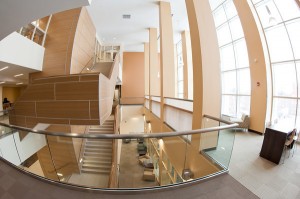The new home of the Margaret Warner Graduate School of Education and Human Development, Raymond F. LeChase Hall, was built with regard to the principles and practices of Leadership in Energy and Environmental Design (LEED). LEED consists of ranking systems for the design, construction, and maintenance of buildings, homes, and neighborhoods. There are four levels of LEED – Certified, Silver, Gold, and Platinum. To achieve higher rankings, points are awarded for high performance in implementing environmentally friendly technology and designs. LeChase Hall has been built to the standards of LEED Silver.
Construction can be a large contributor to waste generation, and thus prioritizing careful disposal and segregation of materials for reuse is beneficial in reducing waste. In the construction of LeChase Hall, 91.7% of construction waste was recycled or diverted from the landfill for other uses. This includes asphalt, metal, wood, glass, tin, paper, and concrete that was generated during construction.

When ordering items for purchase, Campus Planning, Design, and Construction Management sought materials that were either regional (within 500 miles) or made from recycled materials. Both of these qualities are emphasized by LEED as an important consideration when constructing a more sustainable building. In occupied space, concessions were made to reduce water and energy consumption. Bathroom faucets and toilets are all low flow. Room lighting and temperature respond to occupancy sensors. To protect people and air quality, all carpets, paints, and sealants contain low or no volatile organic compounds (VOCs). Occupant health is emphasized by LEED as well.
On the outside, all bordering landscaping is water efficient and includes multiple rain gardens. The ramps on the left and right of the building are designed to direct stormwater runoff into these planting beds. This multipurpose design is just one of the ways innovation can benefit people and the environment.
Adjacent to the ramps, the main entrance steps are made from regional granite and slate. The windows are insulated to provide outdoor views without compromising building efficiency. White roofing materials that reflect sunlight and thus reduce heat transfer into the building were used at the flat portions of the roof. This decreases the amount of energy needed to cool the building and reduces greenhouse gas emissions.
LeChase is the latest project to join the University’s collection of sustainable buildings. The most prominent would be Saunders Clinical and Translational Science Research Building which is certified LEED Gold. Robert B. Goergen Biomedical Engineering Building and O’Brien Hall are both built to LEED standards. This fleet of new buildings, all with considerable design accomplishments, shows the University to be a leader in sustainable design and commitment.
Click here for more photographs taken by University Photographer Adam Fenster.
By Alanna Scheinerman, Class of 2013

